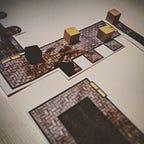On Initiative (Them Deeper Bones, design diary 6)
Been a while since I last wrote here, because I’ve been knee-deep in playtesting land. Them Deeper Bones is my OSR-adjacent retro adventure game. The current full text (as of writing, version a.9.1, the final Alpha version before the Beta playtest release) of Them Deeper Bones can be found in Google Drive. I touched the initiative system earlier in the Combat article, but I’d like to talk about the idea of the OODA loop and its relation to initiative since that’s something I had a long discussion about elsewhere and it didn’t come up in the original article at proper detail.
One of the first things in TDB’s game design for me was to adopt AD&D 2e’s initiative system, or at least a close analogue of it. Initiative is rolled after the decisions of what’s going to happen during the combat turn have been made.
This is because one of the things that really slow down combat in many modern games is the “orient” part of an OODA Loop. What is the OODA Loop? It comes from the four words “observe” ”orient” ”decide” ”act” and it’s the decision-making loop that combat rounds consist of when playing tactical games such as role-playing combat. We first observe what actions others take. Then we orient to our current situation based on our observations. We decide on a course of action based on our view of the situation. And then act based on that decisions.
I’ll first go through this through the lens of a more traditional game.
In the game, most of our time is spent on observing. Everyone in a combat situation takes their actions on their turns, taking their time, and we see what effects each of those actions cause. Then it comes to our turn in the initiative order, and now we have to orient to what the situation actually is. The player who acted earlier almost got their character killed from a nasty attack, and the enemy who was out in the open has now moved behind a corner. We will be asking clarifying questions to the GM, who is our window to the truths of the world. Anything that we couldn’t properly observe earlier needs to be clarified based on the current version of the situation. We will come up with a few options of what we could do at this point and then commit to one, deciding that it’s the one. Then comes the part where we act out the decision, see how the situation plays out as we roll the dice, and the turn passes on to the next person.
This approach is bad to two things in the moment. 1) When it is our turn to act, we need to spend a lot of time to orient to the current situation as things might have just drastically changed because of the previous action. This slows our decision-making process a lot, and 2) We end up not really caring so much on what happens on everyone else’s turns except a) it’s the person just before us, as the situation can change completely because of what they do, and b) if someone targets us, since that might hurt our character.
So. The solution? Use the initiative system where actions are declared first, then initiative is rolled and then actions are resolved.
With this model, again, most of our time is spent on observing what happens in the game. We gain information as actions in combat progress and when a new combat round starts, it begins with the GM (“guide” in TDB) announcing the actions of all the opponents to us. We then get the opportunity to together orient to this situation. Everyone is at the situation where they’re figuring out what’s happening and if one of us asks a question about it, everyone gains further data from the answer. We can discuss our options, and then commit to a decision. Then the initiative roll happens and our characters act in the given order.
What this does is it puts the orientation and decision stages of each and every player in the same temporal slot. So instead of everyone having to do that the second their initiative comes up, we can do it simultaneously, supporting one another. Playtesting has made it clear that this is a very efficient system when it comes to time.
So, that’s why I’m using the old favorite system of mine in the design. It’s just damn fast in comparison.
Edit: Two important things that need to be said (well one emphasised, one said) — The guide announces all their actions first, this way there is no slapstick as the player characters muck about accomplishing nothing. And if a character would end up missing their action because of changing circumstances, they are placed on top of the initiative order next round as a ccompensation.
